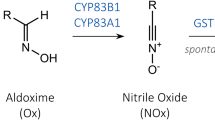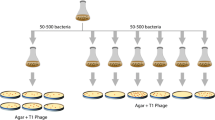Abstract
Development of recombinant enzymes as industrial biocatalysts or metabolic pathway elements requires soluble expression of active protein. Here we present a two-step strategy, combining a directed evolution selection with an enzyme activity screen, to increase the soluble production of enzymes in the cytoplasm of E. coli. The directed evolution component relies on the innate quality control of the twin-arginine translocation pathway coupled with antibiotic selection to isolate point mutations that promote intracellular solubility. A secondary screen is applied to ensure the solubility enhancement has not compromised enzyme activity. This strategy has been successfully applied to increase the soluble production of a fungal endocellulase by 30-fold in E. coli without change in enzyme specific activity through two rounds of directed evolution.
Access this chapter
Tax calculation will be finalised at checkout
Purchases are for personal use only
Similar content being viewed by others
References
Singh R, Kumar M, Mittal A et al (2016) Microbial enzymes: industrial progress in 21st century. 3 Biotech 6(2):174
Chapman J, Ismail AE, Dinu CZ (2018) Industrial applications of enzymes: recent advances, techniques, and outlooks. Catalysts 8(6):238
Kunjapur AM, Pfingstag P, Thompson NC (2018) Gene synthesis allows biologists to source genes from farther away in the tree of life. Nat Commun 9(1):4425
Wiltschi B, Cernava T, Dennig A et al (2020) Enzymes revolutionize the bioproduction of value-added compounds: from enzyme discovery to special applications. Biotechnol Adv 40:107520
Smanski MJ, Zhou H, Claesen J et al (2016) Synthetic biology to access and expand nature’s chemical diversity. Nat Rev Microbiol 14(3):135–149
Erb TJ, Jones PR, Bar-Even A (2017) Synthetic metabolism: metabolic engineering meets enzyme design. Curr Opin Chem Biol 37:56–62
Brondyk WH (2009) Selecting an appropriate method for expressing a recombinant protein. Methods Enzymol 463:131–147
Ziemert N, Alanjary M, Weber T (2016) The evolution of genome mining in microbes - a review. Nat Prod Rep 33(8):988–1005
Yan Q, Fong SS (2017) Challenges and advances for genetic engineering of non-model bacteria and uses in consolidated bioprocessing. Front Microbiol 8:2060
Liu L, Yang H, Shin HD et al (2013) How to achieve high-level expression of microbial enzymes: strategies and perspectives. Bioengineered 4(4):212–223
Bundy BC, Hunt JP, Jewett MC et al (2018) Cell-free biomanufacturing. Curr Opin Chem Eng 22:177–183
Makino T, Skretas G, Georgiou G (2011) Strain engineering for improved expression of recombinant proteins in bacteria. Microb Cell Factories 10:32
Ferrer-Miralles N, Saccardo P, Corchero JL et al (2015) General introduction: recombinant protein production and purification of insoluble proteins. Methods Mol Biol 1258:1–24
Sorensen HP, Mortensen KK (2005) Soluble expression of recombinant proteins in the cytoplasm of Escherichia coli. Microb Cell Factories 4(1):1
Baneyx F (1999) Recombinant protein expression in Escherichia coli. Curr Opin Biotechnol 10(5):411–421
Terpe K (2006) Overview of bacterial expression systems for heterologous protein production: from molecular and biochemical fundamentals to commercial systems. Appl Microbiol Biotechnol 72(2):211–222
Rosano GL, Ceccarelli EA (2014) Recombinant protein expression in Escherichia coli: advances and challenges. Front Microbiol 5:172
Gupta SK, Shukla P (2016) Advanced technologies for improved expression of recombinant proteins in bacteria: perspectives and applications. Crit Rev Biotechnol 36(6):1089–1098
Eijsink VG, Bjork A, Gaseidnes S et al (2004) Rational engineering of enzyme stability. J Biotechnol 113(1–3):105–120
Sachsenhauser V, Bardwell JC (2018) Directed evolution to improve protein folding in vivo. Curr Opin Struct Biol 48:117–123
Fisher AC, DeLisa MP (2004) A little help from my friends: quality control of presecretory proteins in bacteria. J Bacteriol 186(22):7467–7473
Fisher AC, Kim W, DeLisa MP (2006) Genetic selection for protein solubility enabled by the folding quality control feature of the twin-arginine translocation pathway. Protein Sci 15(3):449–458
Fisher AC, DeLisa MP (2009) Efficient isolation of soluble intracellular single-chain antibodies using the twin-arginine translocation machinery. J Mol Biol 385(1):299–311
Klesmith JR, Bacik JP, Wrenbeck EE et al (2017) Trade-offs between enzyme fitness and solubility illuminated by deep mutational scanning. Proc Natl Acad Sci U S A 114(9):2265–2270
An WF, Tolliday NJ (2009) Introduction: cell-based assays for high-throughput screening. Methods Mol Biol 486:1–12
Boock JT, Gupta A, Prather K (2015) Screening and modular design for metabolic pathway optimization. Curr Opin Biotechnol 36:189–198
Denard CA, Ren H, Zhao H (2015) Improving and repurposing biocatalysts via directed evolution. Curr Opin Chem Biol 25:55–64
Longwell CK, Labanieh L, Cochran JR (2017) High-throughput screening technologies for enzyme engineering. Curr Opin Biotechnol 48:196–202
Boock JT, King BC, Taw MN et al (2015) Repurposing a bacterial quality control mechanism to enhance enzyme production in living cells. J Mol Biol 427(6 Pt B):1451–1463
DeLisa MP, Tullman D, Georgiou G (2003) Folding quality control in the export of proteins by the bacterial twin-arginine translocation pathway. Proc Natl Acad Sci U S A 100(10):6115–6120
King BC, Donnelly MK, Bergstrom GC et al (2009) An optimized microplate assay system for quantitative evaluation of plant cell wall-degrading enzyme activity of fungal culture extracts. Biotechnol Bioeng 102(4):1033–1044
Fisher AC, Kim JY, Perez-Rodriguez R et al (2008) Exploration of twin-arginine translocation for expression and purification of correctly folded proteins in Escherichia coli. Microb Biotechnol 1(5):403–415
Fromant M, Blanquet S, Plateau P (1995) Direct random mutagenesis of gene-sized DNA fragments using polymerase chain reaction. Anal Biochem 224(1):347–353
Farrow MF, Arnold FH (2011) High throughput screening of fungal endoglucanase activity in Escherichia coli. J Vis Exp 54:e2942
Romero PA, Arnold FH (2009) Exploring protein fitness landscapes by directed evolution. Nat Rev Mol Cell Biol 10(12):866–876
Acknowledgments
This material is based upon work supported by a USDA NIFA Grant # 2009-02202 (D.M.G and M.P.D.), an NSF GK-12 “Grass Roots” Fellowship under Grant # DGE-1045513 (J.T.B.), and Miami University Assistant Professor start-up funds (J.T.B.).
Author information
Authors and Affiliations
Corresponding author
Editor information
Editors and Affiliations
Rights and permissions
Copyright information
© 2022 Springer Science+Business Media, LLC, part of Springer Nature
About this protocol
Cite this protocol
Boock, J.T., Taw, M., King, B.C., Conrado, R.J., Gibson, D.M., DeLisa, M.P. (2022). Two-Tiered Selection and Screening Strategy to Increase Functional Enzyme Production in E. coli. In: Garcia Fruitós, E., Arís Giralt, A. (eds) Insoluble Proteins. Methods in Molecular Biology, vol 2406. Humana, New York, NY. https://doi.org/10.1007/978-1-0716-1859-2_10
Download citation
DOI: https://doi.org/10.1007/978-1-0716-1859-2_10
Published:
Publisher Name: Humana, New York, NY
Print ISBN: 978-1-0716-1858-5
Online ISBN: 978-1-0716-1859-2
eBook Packages: Springer Protocols




